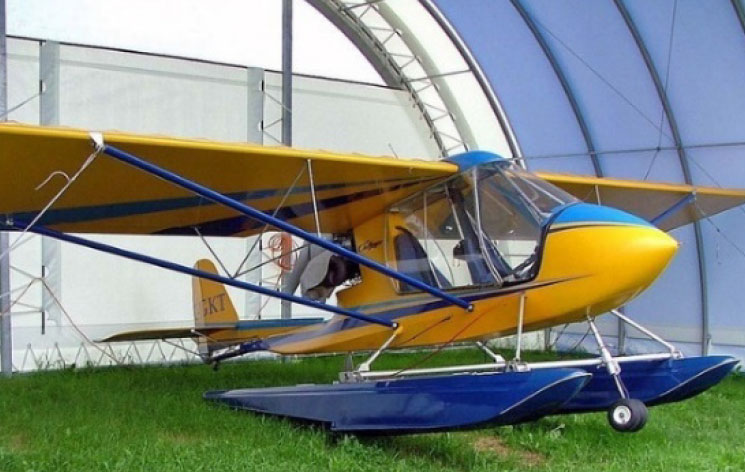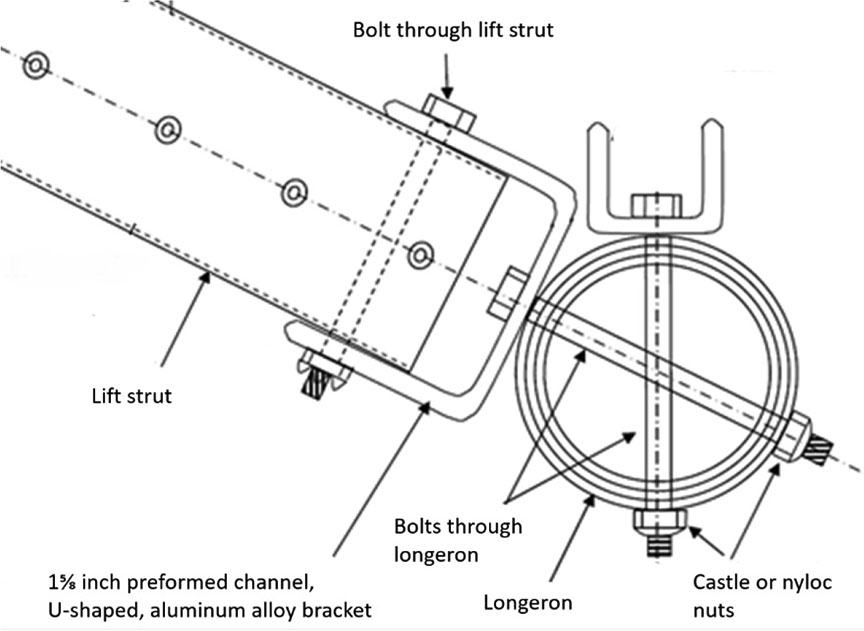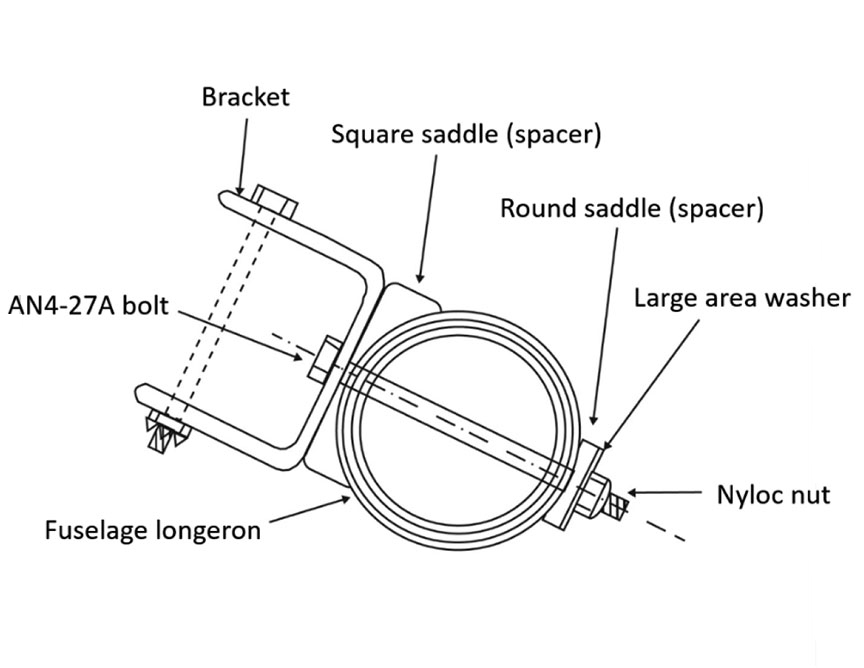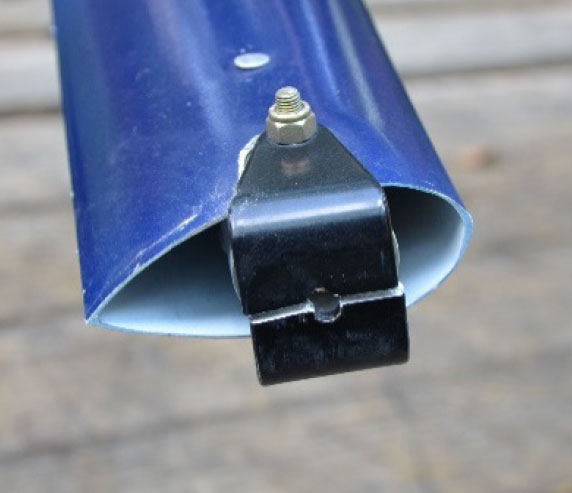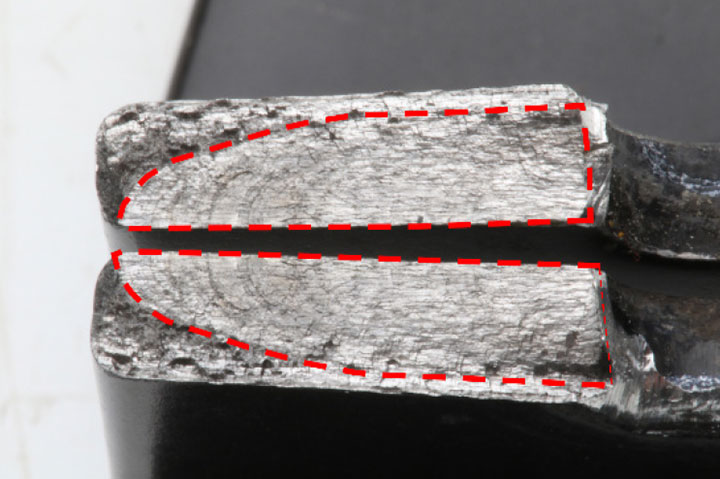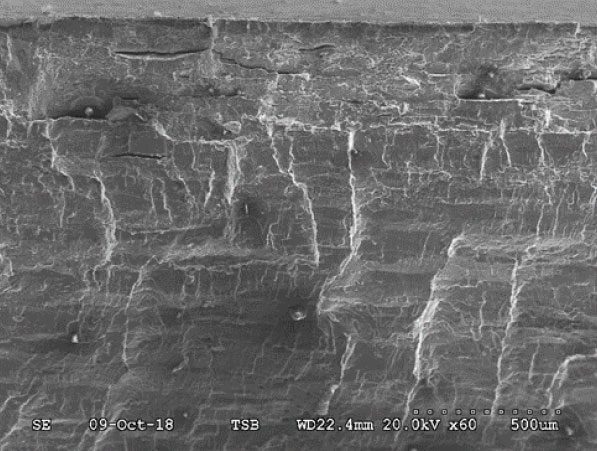In-flight separation of right wing
Quad City Challenger II (advanced ultralight), C-IGKT
North Bay, Ontario, 14.3 nm E
The Transportation Safety Board of Canada (TSB) investigated this occurrence for the purpose of advancing transportation safety. It is not the function of the Board to assign fault or determine civil or criminal liability. This report is not created for use in the context of legal, disciplinary or other proceedings. See Ownership and use of content. Masculine pronouns and position titles may be used to signify all genders to comply with the Canadian Transportation Accident Investigation and Safety Board Act (S.C. 1989, c. 3).
History of the flight
On 29 July 2018, 2 privately operated Quad City Ultralight Aircraft Corporation (Quad City) Challenger II advanced ultralight aircraft equipped with amphibious floats departed Ottawa/Rockcliffe Airport (CYRO), Ontario, for a daytime visual flight rules cross-country flight to North Bay Airport (CYYB), Ontario. While en route, the 2 aircraft encountered strong winds and turbulence, and the pilots decided to land on the Ottawa River, near Mattawa, Ontario. During the landing, the occurrence aircraft (registration C-IGKT, serial number CH2-1199-1919) touched down hard. After a short lunch break, the pilots inspected the 2 aircraft and then flew to CYYB without further incident.
On 30 July 2018, the 2 aircraft departed CYYB at 0932Footnote 1 and climbed to between 1800 and 2000 feet above sea level for the return flight to CYRO. At approximately 0950, the occurrence aircraft's right wing separated from the aircraft when it was over Talon Lake, Ontario, 14.3 nautical miles east of CYYB. The aircraft entered an uncontrolled descent and collided with terrain in a wooded area. A post-impact fire ensued. The pilot was fatally injured. The aircraft was destroyed by impact forces and the post-impact fire.
The pilot of the other aircraft overflew the occurrence site and landed on Talon Lake. At 0959, he met a local resident, who called 911 to report the accident. There was no emergency locator transmitter on board, and none was required by regulations.
Weather information
The aviation routine weather report (METAR) for CYYB at the time of departure indicated winds from 230° true (T) at 9 knots, variable from 210°T to 270°T; visibility of 10 statute miles with smoke; and a layer of scattered cloud based at 600 feet above ground level. Weather reports for the planned route indicated that the weather was suitable for the visual flight rules flight.
Pilot information
Records indicate that the pilot was certified and qualified for the flight in accordance with existing regulations. He obtained a private pilot licence – aeroplane in December 2004 and had a valid Category 3 medical certificate. He had accumulated over 1330 total flying hours, with over 1230 hours on ultralights. The investigation found no evidence to indicate that the pilot's performance was degraded by fatigue or other physiological issues.
Aircraft information
Quad City has been manufacturing Challenger ultralight kits since 1983. The Challenger is sold exclusively as a quick-build kit with several options, including engine upgrades, long or clipped wings, and single- or 2-seat cockpits. The aircraft can be equipped with wheels, skis, or amphibious floats. The company has sold over 4400 Challengers worldwide, including 608 in Canada.
Since the mid-1990s, most new Challengers in Canada have been registered with Transport Canada (TC) in the advanced ultralight category. At November 2018, of the 608 Challengers on the TC registry, 405 were in the advanced ultralight category, 195 were in the basic ultralight category, and 8 were in the amateur-built category.Footnote 2,Footnote 3
The occurrence aircraft was manufactured and registered as an advanced ultralight in 2000. The occurrence pilot purchased the aircraft in May 2008. It was a 2-seat, long-wing variant with a 29.5‑foot wingspan. Depending on the season, the aircraft was flown on wheels, skis, or amphibious floats. At the time of the occurrence, the aircraft was equipped with amphibious floats (Figure 1). The aircraft was also equipped with a heavy load saddle kit.
Lift strut attachment to the fuselage
The wings are supported by lift struts that are attached to the fuselage with 1⅝ inch preformed channel, U-shaped, aluminum alloy brackets. The brackets are attached to the lift struts using a bolt that passes through the bolt holes on each leg of the bracket and through a pre-drilled hole in the lift strut. The brackets and struts are then attached to the fuselage longeron using a bolt that passes through a bolt hole in the centre base plate of the bracket. Castle nuts or nyloc nuts are used to secure the bolts (Figure 2).
Heavy load saddle kit
The heavy load saddle kit was developed to provide the Light Sport version of the Challenger ultralight aircraft with greater lift and performance capabilities. It is a set of 2 spacers fitted to the fuselage longeron and provides a flat surface area at the attachment point with the bracket (Figure 3).
Maintenance
Advanced ultralights in Canada are required to be maintained in accordance with the manufacturer's recommendations. According to TC's Ultra-light Aeroplane Transition Strategy, manufacturers must provide owners with “a specified maintenance program that includes the inspection schedule and the maintenance procedures […] and Mandatory ActionFootnote 4 information issued by the manufacturer or TC and any corrective procedures for potential unsafe flight conditions.”Footnote 5 Aircraft owners are required to “maintain appropriate records for the aeroplane which must include scheduled maintenance, mandatory action, modifications and accident repairs.”Footnote 6
Quad City's manufacturer-specified maintenance program includes 50-hour inspections and high-time airframe inspections. In June 2014, the occurrence aircraft underwent a high-time airframe inspection after it had accumulated 1047.4 hours total time since new, and was refurbished with several new parts, new fabric, and paint. When the aircraft was returned to service, the spar and strut brackets had been replaced, and the streamline fairings over the main lift struts were new; however, the struts themselves were the originals from 2000.
The Quad City Challenger Owner's Manual lists the steps required to assemble the aircraft kit, including instructions to attach the wing spars and struts to the fuselage. The instructions specify that the bolts holding the brackets are to be tightened until snug.Footnote 7
The owner's manual also indicates that the brackets and their associated bolts and nuts are to be inspected for tightness, cracks, play, and safeties at the 50-hour inspection.Footnote 8 These are visual inspections only. The manual does not specify any recommended torque values to be used, the inspection methods to be used, or the type of inspections to be performed to identify possible cracking.
At the time of the occurrence, the aircraft had accumulated approximately 1450 hours. The aircraft's journey log showed that the occurrence pilot was completing inspections at 25-hour intervals, rather than the 50-hour intervals recommended by the manufacturer, and that one of these 25-hour inspections had been completed on 06 May 2018. The manufacturer does not require or have a specific checklist for a 25-hour inspection, and it could not be determined if these inspections were conducted using the 50-hour inspection checklist, or if the brackets were inspected as required.
The Quad City Challenger Owner's Manual states that the brackets are to be replaced completely at 500 hours time-in-service.Footnote 9 The aircraft journey log indicated that all brackets had been replaced at the high-time airframe inspection conducted in June 2014, and the aircraft had flown approximately 403 hours since that time.
Technical examination
As part of the investigation, both right wing lift struts (front and rear), both right wing spars (front and rear), and the respective brackets were sent to the TSB Engineering Laboratory in Ottawa, Ontario, for examination.Footnote 10 The examination of the failed right front lift strut bracket identified the following:
- A clean and straight fracture line went through the centre of the bolt hole on the bracket. There were no signs of plastic deformation shown on the bracket (Figure 4).
- Arced beach marks indicate that the edge of the bolt hole being the origins of the fatigue. The number of beach marks also indicated that the fatigue had begun some time before the occurrence, although the exact timeframe could not be determined (Figure 5).
- The fracture surface of the fatigue crack was examined under the scanning electron microscope, and a significant number of secondary cracks were found parallel to and underneath the inboard surface of the base of the bracket (Figure 6). These cracks resembled material delamination.
The examination concluded that the bracket that attached the right forward strut to the heavy load saddle on the fuselage had failed under nominal loading condition due to the presence of a large fatigue crack. The fatigue crack, which accounted for at least 60% of the cross-section of the base of the bracket, had been present in the bracket for some time before this occurrence. The secondary delamination cracks that were found in the bracket are considered abnormal for aluminum alloy.
The failure of this bracket allowed the lift strut to detach from the fuselage and the right front spar to twist and rotate upward under aerodynamic load. The right front spar tore away at the bracket attachment point to the main centre beam and caused the wing to fail. Meanwhile, because the right-wing lift forces were no longer being transferred to the fuselage, the lift forces generated by the left wing caused the aircraft to roll to the right. As the right wing continued to fold back, the rear spar and rear lift strut failed, and the wing separated from the aircraft. This right wing separation resulted in an unrecoverable loss of control and collision with terrain.
It was determined that the fatigue crack on the right front lift strut bracket went undetected during the routine inspection cycle undertaken by the pilot and failed before the 500-hour stipulated life span. Although a bolt longer than specified had been used to attach the bracket to the lift strut, there was no evidence to indicate that the bolt had been overtightened or over-torqued. It could not be determined whether the hard landing the day before the accident contributed to the bracket failure.
Examination of brackets installed on other aircraft
To determine if this issue was isolated to the occurrence aircraft, the TSB examined lift strut brackets from 6 other Quad City Challenger II aircraft. Of these, 4 were based in the Ottawa area and 2 were based in the Toronto area.Footnote 11 Twenty-one strut brackets from these aircraft, each of similar construction to the occurrence bracket, were examined visually. Some were also examined under an optical microscope or scanning electron microscope. Of the 21 brackets, 8 were found to have cracks. The cracks varied in size and origin; however, their actual lengths and depths were not determined. Some cracks resulted from fatigue, whereas others were caused by material delamination.
The time-in-service of these brackets ranged from approximately 4 hours to 829 hours,Footnote 12 and the brackets had been manufactured between 1996 and 2018.Footnote 13 At the time of this examination, none of the aircraft from which these brackets were taken were owned or operated by the original owner; they had all been through multiple changes of ownership. The investigation did not examine the individual aircraft assemblies, operating histories, or maintenance documents, nor did it examine in detail the manufacturing process of the brackets.
Previous occurrences and related activities
Canada: Transport Canada and Transportation Safety Board of Canada
A search of TC and TSB databases for occurrences from 1993 to 2018 found 245 reported incidents and accidents involving the Challenger II aircraft. None of these occurrences specified wing separation or failure of the bracket as a contributing or causal factor.
United States: National Transportation Safety Board
The U.S. National Transportation Safety Board (NTSB) published a report following an investigation into an occurrence involving a Quad City Challenger on 12 June 2007 near Lodi, California, United States.Footnote 14 The aircraft was damaged when its right wing separated in flight. The report stated that the bracket had failed and had not been attached as per the aircraft's owner's manual. The report states:
The manufacturer's instructions state that the bolt should only be snug. It also warns to not over tighten these bolts holding the brackets to the hollow tubes and that there should be no more than two threads showing past the nut. The bolt on this [bracket], on the accident aircraft, had at least five to six threads showing. Additionally, the end of the hollow tube was deformed into an oval shape and not round. The remaining [brackets] did have only two threads showing and they could be rotated by hand, per the manufacturer's instructions.Footnote 15
United Kingdom: Light Aircraft Association
The Light Aircraft Association (LAA) oversees the airworthiness of amateur-built aircraft in the United Kingdom. The LAA provides airworthiness information for 3 different Challenger variants: the Quad City Challenger, the BFC Challenger II, and the BFC Challenger II-SE (Long Wing).Footnote 16
Shortly after the 2007 accident in the U.S., the LAA issued MOD/177/015, Inspection of Lift Strut Lower Attachment Brackets,Footnote 17 which introduced mandatory inspections of lift strut lower brackets for all variants. MOD/177/015 indicated that
All Quad City Challenger II aircraft in the U.K. have been modified by the addition of shaped aluminium cups between the brackets and the fuselage longerons and a washer fitted under the bolt head (MOD/177/009). This modification, whilst improving the load carrying characteristics of the bracket, had the negative effect of making it difficult to inspect for signs of cracks without first removing the bracket.
All BFC Challenger II and BFC Challenger II (Long Wing) in the U.K. have been further modified by the addition of a sleeve through the fuselage longeron preventing over tightening of the through bolt. In addition, the bracket was rotated through 90˚ to prevent the possibility of bending loads in the bracket […].Footnote 18
MOD/177/015 also included the following required action:
Remove the four lift strut lower attachment brackets and inspect using x10 magnification in good light for signs of cracking, hole elongation, distortion, scuffing or corrosion. If the bracket is defective in any way it must be replaced before further flight. It should be noted that this bracket is made from a special high strength aluminium alloy and new brackets, if required, must be sourced from the kit manufacturer.Footnote 19
The notice further specified different re-assembly procedures for the Quad City and BFC variants.
In 2018, the LAA published an updated Type Acceptance Data Sheet,Footnote 20 which provides general, mandatory, and advisory information about the aircraft type. In the “mandatory information” section, the data sheet lists all required modifications for all U.K.-registered Challenger II (Quad City and BFC) aircraft, including both MOD/177/009 and MOD/177/015. It specifies that the front lift strut attachment brackets on all U.K. Challengers, whether BFC or not, are to be fitted with load spreader washers under the bolt heads and with shaped cups under the brackets. Separate instructions for the BFC Challenger II variants specify that the brackets are to be rotated through 90°, and that a longer attachment bolt is to be used and fitted with a bush through the fuselage tube to allow the nut to be torqued up to 70 inch pounds.
Safety message
The lift strut brackets used on the Quad City Challenger II have been in service for 35 years and are installed on more than 4400 aircraft worldwide, of which 608 are in Canada. In this accident, a fatigue crack on the right front lift strut bracket went undetected during the routine inspection cycle undertaken by the pilot, and the bracket failed in flight before the 500-hour stipulated life span. The failure led to the right wing separating from the aircraft, resulting in an unrecoverable loss of control and collision with terrain. Examination of additional brackets obtained from other aircraft, with various amounts of time-in-service, found that fatigue and delamination cracks are not isolated to the occurrence bracket.
As this occurrence demonstrates, it is possible for fatigue and delamination crack failures to occur on these brackets within recommended time-in-service limits and to remain undetected during basic manufacturer-recommended inspection practices. Cracks that develop on an airframe component need to be identified before the component fails completely. This is especially true when the component's failure can result in an irrecoverable loss of control in flight.
Safety actions taken or underway
On 15 November 2018, the TSB issued a safety advisoryFootnote 21 to inform TC, the manufacturer, and other stakeholders about the issue and encourage them to take the necessary steps to reduce the likelihood of the bracket failure identified in this occurrence happening again.
Quad City is conducting a stress analysis on the addition of a fixture under the head of the bolt that secures the lower strut attachment brackets to the fuselage longerons. The purpose of this fixture is to reduce flexing and spread loads around the bolt hole where fatigue cracks appear to start.
TC, Quad City, the Canadian distributor of the Challenger II, and other agencies are working together to determine the causes of the failure and to publish safety alerts with amended maintenance directives and inspection processes. The purpose of the safety alerts will be to
- provide details on the possibility of cyclic loading of the lower strut attachment brackets;
- require the removal and inspection of the brackets before further flight;
- require that installation, configuration, inspection, assembly and replacement criteria and processes be amended;
- require that maintenance checklists and the high-time airframe inspection document be amended;
- require that bracket inspection and replacement intervals be amended;
- provide information on the bracket service life for aircraft used as trainers and those operating in rough terrain;
- warn against using the strut-to-fuselage junction as a step or installing fuel tanks or baggage pods on the main struts or jury struts; and
- recommend that the heavy load saddle kit be installed.
On 01 March 2019, TC published Civil Aviation Safety Alert 2019-02Footnote 22 to address the issue.
Quad City intends to issue a safety alert to Challenger owners that will explain the updated maintenance instructions.
This report concludes the Transportation Safety Board of Canada's investigation into this occurrence. The Board authorized the release of this report on . It was officially released on .
